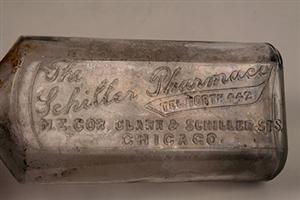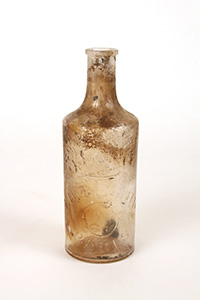-
Membership
Membership
Anyone with an interest in the history of the built environment is welcome to join the Society of Architectural Historians -
Conferences
Conferences
SAH Annual International Conferences bring members together for scholarly exchange and networking -
Publications
Publications
Through print and digital publications, SAH documents the history of the built environment and disseminates scholarshipLatest Issue:

-
Programs
Programs
SAH promotes meaningful engagement with the history of the built environment through its programsMember Programs
-
Jobs & Opportunities
Jobs & Opportunities
SAH provides resources, fellowships, and grants to help further your career and professional life -
Support
Support
We invite you to support the educational mission of SAH by making a gift, becoming a member, or volunteering -
About
About
SAH promotes the study, interpretation, and conservation of the built environment worldwide for the benefit of all
Gold Coast’s Buried Relics: Artifacts from the Charnley-Persky House Dig
Visitors to the Charnley-Persky House Museum in Chicago have a chance to peek into the butler’s pantry behind the dining room on the first floor. Displayed in the cabinets are rusted pots and pans, medicinal bottles and jars, and shards of broken china dishes. These artifacts were discovered when the historic house and current headquarters of the Society of Architectural Historians was undergoing extensive renovation work in 2002. Construction work on the foundation and vaulted sidewalk required digging an eight-foot deep trench along the foundation wall in order to install waterproofing material below grade. Beneath the driveway on the east (back) side of the house, the workmen discovered a late 19th-century midden with a variety of refuse left behind by the inhabitants of Gold Coast from about a hundred years ago.
Beginning in the mid 2000s, staff members at SAH worked to categorize, document, and preserve materials from the area. In 2009, in the hopes that a professional excavation would uncover further insight into the development of the Gold Coast neighborhood and the lifestyles of the families that resided here, Pauline Saliga, executive director of SAH, contacted Rebecca S. Graff who had been a doctoral candidate in anthropology at the University of Chicago at the time. (Graff is now a visiting assistant professor of anthropology at the Michigan Technological University.) With experience in leading urban excavations of the 1893 World’s Columbian Exposition site in Chicago’s Jackson Park already under her belt, Graff led a field school for DePaul University students during the summer of 2010. The undergraduate students had the opportunity to learn the tenets and practices of historical archaeology including stratigraphic excavation and soil sampling.
Most of the collection consists of glass bottles and jars that contained medicine, cosmetics, food and other condiments. Some of them were imported from across the pond, such as cologne from the Parisian perfumer Ed. Pinaud, attesting to the affluence of the families that lived in this neighborhood. A few of the bottles are local, such as from the Schiller Company, an apothecary that was just a few blocks away on the northeast corner of Clark and Schiller streets. Broken shards of fine china from France, Germany, England, and Asia were also found in the midden.

This medicinal bottle is embossed with the name of the local Schiller Pharmacy whose store sat on the northeast corner of Clark and Schiller streets, just three blocks west of the Charnley-Persky House. As the embossing “Tel North 442” shows, the telephone numbering convention in 19th century Chicago was a name followed by three digits.
The ownership of the garbage salvaged from the pit remains a mystery. It seems unlikely that a cultured family such as the Charnleys would have buried trash next to the house. Moreover, a graduated nursing bottle and a tiny clay toy in the shape of a pipe indicate that the artifacts of young children were in the midden. According to the 1900 census, however, the residents of the house were James and Helen Charnley, their 26-year-old son Douglas, a boarder the same age as the son, a brother-in-law, and two Swedish servants, Hannah Larson and Annie Carlson, with no evidence that a young child lived in the house. Rather, these items may have belonged to the Potter Palmer household whose grounds originally included the land on which the Charnley-Persky House was constructed. They also may have come from the 1890s apartment building immediately to the east of Charnley House. Although these items may or may not have belonged to the Charnleys, they do date to the period of the Charnley occupancy and are representative of the types of items that would have been used in their household.

Ed. Pinaud’s Cologne, Paris.
As part of my summer internship at SAH, I was able to photograph about 100 of these artifacts. The image gallery on the Charnley-Persky House Museum website highlights some of the retrieved items. From these buried relics, we can surmise fascinating stories of the Charnley House’s former occupants or their neighbors – someone was interested in photography and developed albumen prints, while another was occupied with perhaps filling in a bald spot with hair growth tonic – providing a retrospective glimpse into the daily lives of the Gold Coast’s well heeled society in the late 19th century.
Christine Shang-Oak Lee is a 2013 Jeff Metcalf Fellow at the Society of Architectural Historians and a fourth-year undergraduate at the University of Chicago studying art history. She is currently researching Western-style architecture in Korea built during its colonial period. On campus, you can find her in the projectionist booth with her hands tangled in old film reels at the student-run Doc Films or drumming away infectious beats in the traditional Korean percussion group.


Leave a commentOrder by
Newest on top Oldest on top